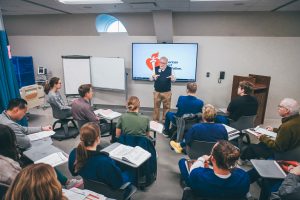41 Facilitating Discussions
Discussions can be a powerful teaching strategy, enhancing student motivation, intellectual agility, and democratic habits. When thoughtfully planned and facilitated, they provide a space for students to articulate and defend positions, evaluate evidence, and consider multiple perspectives. However, discussions are inherently unpredictable and require instructors to surrender some control over the flow of information. This unpredictability can be daunting, but with careful preparation, discussions can achieve a balance between lively exploration and focused learning.
This section explores strategies to plan and lead effective discussions, organized around three critical aspects: cognitive, social/emotional, and physical factors.
Cognitive Factors: Guiding the Intellectual Process
-
Determine and Communicate Learning Objectives
Effective discussions begin with a clear purpose. What should students learn or practice during the discussion? Your objectives might include:
- Analyzing Arguments: Compare evidence and perspectives in assigned readings.
- Creative Problem-Solving: Develop and defend a design for a sustainable city.
- Practical Application: Formulate policy recommendations for a contemporary issue.
Clearly articulating and sharing these objectives with students helps focus their thinking and motivates meaningful participation.
-
Plan a Strategy
A well-thought-out plan provides structure while allowing room for flexibility. Key considerations include:
- Preparation: Should students read a case study, complete a reflection, or watch a video beforehand?
- Framing Questions: What questions will stimulate discussion and deeper analysis?
- Participation Formats: Will the discussion involve the whole class, small groups, or pairs?
- Managing Challenges: How will you address dominance, digressions, or silence?
Having a plan ensures that discussions align with learning goals and adapt to students’ needs.
-
Ask Good Questions
Good questions spark engagement and promote critical thinking. Consider these types:
- Exploratory: Probe for facts or foundational knowledge.
- Relational: Draw comparisons between ideas or themes.
- Hypothetical: Explore the implications of changes in context.
- Summary: Synthesize key points and insights.
Start with convergent questions (e.g., “What are the main arguments in the reading?”) to establish shared understanding, then transition to divergent questions (e.g., “What are the broader implications of these arguments?”) for deeper exploration.
Common Questioning Errors
When instructors are nervous that a discussion might flag, they tend to fall prey to some common questioning errors. These include:
Asking too many questions at once: Instructors often make the mistake of asking a string of questions together, e.g., “What do you think the author is trying to say here? Do you agree with him? Is his evidence convincing? Did you like this article?” Students may get confused trying to figure out which question to address first. Asking a number of questions together may also conflate issues you really want to help students distinguish (for example, the author’s thesis versus the kinds of evidence he uses to support it).
Asking a question and answering it yourself: We have all had the experience of asking a question only to encounter blank stares and silence. The temptation under these circumstances is to jump in and answer your own question, if only to relieve the uncomfortable silence. Don’t assume, though, that students’ silence necessarily indicates that they are stumped (or unprepared); sometimes they are simply thinking the question through and formulating an answer. Be careful not to preempt this process by jumping in too early.
Failing to probe or explore the implications of answers: One mistake instructors can make in leading a discussion is not to follow up sufficiently on student contributions. It is important not only to get students talking, but to probe them about their reasoning, ask for evidence, explore the implications of what they say, etc. Follow-up questions push students to think more deeply, to substantiate their claims, and consider the practical impact of particular perspectives.
Asking unconnected questions: In the best discussions, there is a logical progression from question to question so that, ultimately, the discussion tells (or reveals) a story. When you are planning your discussion questions, think about how they fit together.
Asking yes/no or leading questions: Asking questions with a yes/no answer can be the starting point of a good discussion, but only if there is a follow-up question that calls for explanation or substantiation. Otherwise, yes/no questions tend to be conversation-stoppers. By the same token, discussions can stall if the instructor’s questions are overly leading, i.e., if there is clearly an answer the instructor wants, and the students’ task is simply to guess it, rather than to think for himself.
Ignoring or failing to build on answers: If students do not feel like their voices have weight in discussion, their motivation to participate drops. Thus, it is important to acknowledge student contributions, responding enthusiastically when they are insightful (“That’s an excellent point, Sarah; could you elaborate further?”) and pointing out when they contain inaccuracies or problematic reasoning (“Take another look at the article, Tranh; is that really what the author is claiming?”). If you do not wish to play such a directive role yourself – and want students to develop the habit of assessing and responding to one another’s contributions – you can throw student comments back to the class for evaluation (for example, “Do the rest of you agree with John’s recommendation? What would be some possible consequences if this plan of action were followed?”)
-
Provide Direction and Maintain Focus
Discussions thrive with a clear focus. Use strategies like summarizing key points mid-discussion or redirecting when off-track (e.g., “How does this connect to our main question?”). Recognize signs of stagnation, such as repetition or apathy, and reinvigorate with new questions or group formats.
-
Bring Closure
Leave time to synthesize the discussion:
- Summarize key insights and unresolved questions.
- Assign a reflection or ask students to identify the most important takeaway.
- Provide 2-3 “big picture” conclusions to reinforce learning objectives.
Social and Emotional Factors: Building Trust and Engagement
-
Demonstrate Relevance
Explain how discussion skills—such as articulating positions or debating respectfully—translate to academic and professional success. Connect topics to students’ interests, contemporary issues, or future goals (e.g., “Think about how you’d explain this policy in a job interview.”).
-
Encourage Participation
Create a supportive environment by:
- Setting Expectations Early: Foster participation from the first class with icebreakers and ground rules (e.g., “Speak respectfully and avoid put-downs”).
- Ensuring Preparation: Assign pre-discussion work to focus student thinking (e.g., reflection prompts, discussion questions).
- Modeling Good Behavior: Demonstrate active listening, respectful disagreement, and thoughtful engagement.
- Providing Alternatives: Use discussion boards or small-group work for students hesitant to speak in large groups.
-
Monitor Group Dynamics
Balance participation by encouraging quieter students and managing dominant voices. Use strategies like calling on students equitably or asking dominant contributors to reflect while others speak.
Anticipate and address emotional or sensitive moments with strategies like pausing for written reflections or reinforcing ground rules.
-
Make High-Quality Participation Count
Define and reward meaningful contributions through a rubric. For example, high-quality participation might include synthesizing ideas, providing evidence, or respectfully challenging perspectives.

High-Impact Tips from ETSU Instructors
 One method I have applied to my own classroom is what I know affectionately as the “Dolly Parton Game.” [Editor’s note: This method was shared by Dr. Amy Johnson. This method is also called Opinion Line-Up.]
One method I have applied to my own classroom is what I know affectionately as the “Dolly Parton Game.” [Editor’s note: This method was shared by Dr. Amy Johnson. This method is also called Opinion Line-Up.]
In this game, students are given a series of questions, one at a time, that revolve around a central topic. In the seminar, for example, we started with the question, “Is Dolly Parton a national treasure?” Students have the freedom to agree with the question, to disagree with it, take a neutral stance, or state that they don’t know/have more questions. In response to each question, students must walk to a designated corner of the room based on their response to the question: agree, disagree, neutral, or don’t know. The students are then asked to justify why they walked to a particular corner of the room. In the process, students can change their minds and walk to different corners of the room as they listen to the answers of their fellow students.
I recently applied this game to my Peace, Security, and Development class on the topic of humanitarian intervention. I started the class by asking students, “Do you believe humanitarian intervention is a good thing for the world?” Once the students chose their sides of the room, it led to a great discussion on the positive and negative drawbacks of humanitarian intervention as well as a discussion on what humanitarian intervention precisely entails. I then followed up with specific questions on episodes of humanitarian intervention that have happened in the past and present such as in Bosnia from 1992 to 1995 and the Ukraine in the present. What was interesting was seeing students shift to different corners of the room and hearing their justifications for why they supported humanitarian intervention in some cases and not others.
Overall, the game was a great way to keep my students active, capture their attention, and share their knowledge with one another. It also is a great way to create more nuanced discussions on class topics.
Michael Bufano | PSCI 3000: Peace, Security, and Development
Physical Factors: Creating a Conducive Environment
-
Arrange the Classroom
Seating arrangements should align with discussion goals. Use a circle or U-shape for dialogic engagement, or clusters for small-group work. For larger classes, use strategies like polling or rotating spokespeople to ensure participation.
-
Adapt to Constraints
Even in less-than-ideal spaces, discussions can thrive. For example, in lecture halls, use tools like microphones or discussion boards to facilitate interaction. Use visuals, such as whiteboards or slides, to track progress and focus attention.
In Conclusion
Effective discussions require thoughtful attention to cognitive, social/emotional, and physical dimensions. By setting clear goals, asking good questions, fostering a welcoming environment, and creating a supportive physical space, instructors can transform discussions into vibrant learning experiences that engage students deeply and develop critical skills.
Sources and Attribution
Primary Source
This section is informed by and adapted from:
- Eberly Center for Teaching Excellence & Educational Innovation, Carnegie Mellon University. Facilitating Discussions.
- Available at: Eberly Center Website
Use of AI in Section Development
This section was developed using a combination of existing research, expert-informed insights, and AI-assisted drafting. ChatGPT (OpenAI) was used to:
- Synthesize key concepts on facilitating effective classroom discussions into a cohesive and accessible guide for instructors.
- Clarify best practices for structuring discussions, encouraging student participation, and managing challenges.
- Enhance readability and coherence, ensuring that discussion strategies are both research-based and practically applicable across disciplines.
While AI-assisted drafting provided a structured foundation, all final content was reviewed, revised, and contextualized to ensure accuracy, pedagogical effectiveness, and alignment with cited sources. This section remains grounded in institutional best practices and respects Creative Commons licensing where applicable.
Media Attributions
- Florence_Joe_9693_high
- CTE Badges (6)
